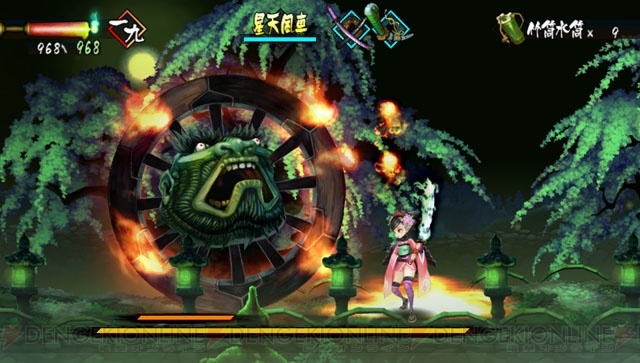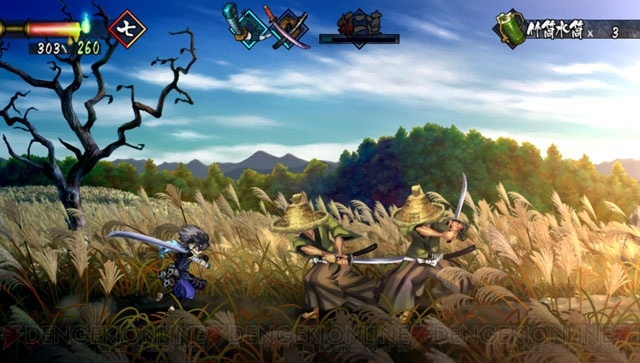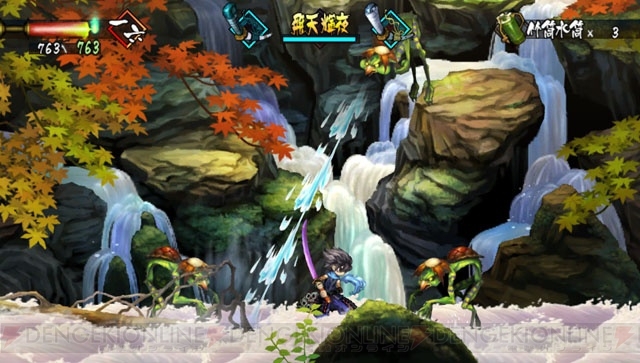Muramasa Rebirth Review
Two Dimensions Are Great, Three’s a Crowd
Everything Vanillaware has created shows how excellent 2D graphics can look when put together by a supremely talented team, but Muramasa Rebirth is the company’s pinnacle of achievement for me. Its environments are gorgeous and fascinating to explore, its narrative kept me interested throughout, combat moves fast but requires paying attention, and the presentation is spectacular. As the Vita recedes from popular consciousness, many of those titles that were formerly exclusives have been making their way elsewhere, but Vanillaware has so far refused to bring this one anywhere else. Unless and until that happens, Muramasa Rebirth provides an extremely compelling reason to keep the Vita around.
Two main narratives are related in Muramasa. One is the story of Kisuke, an amnesiac ninja being assaulted by those who proclaim he did something unforgivable to his fellow shinobi. Kisuke’s initial quest to simply survive is given more purpose upon meeting the noblewoman Torahime, whose pursuit of redemption for her family is supported by all the force he can muster. The other tale is that of Jinkuro and Momohime, respectively a swordmaster whose original body is lost and the young lady whose frame is currently housing his soul. Jinkuro’s goal was never to wind up in Momohime’s body and getting into one more suitable to his purposes is ideal, but the woman occasionally shows enough strength of will to force some alterations to the plan.
Vanillaware’s president George Kamitani wrote the script for Muramasa, and it’s a continually fascinating succession of events occurring to interesting characters. The presentation of these events also deserves credit, given that it conveys the happenings in a visual manner and holds the player’s interest throughout. The narrative may not be airtight in terms of logic, but it errs on the side of keeping the player wanting more instead of overloading information. Aksys Games’ localization complements the setting by being entertaining to read and featuring numerous memorable lines, even though it clearly isn’t concerned with remaining rigidly faithful to the original Japanese line readings. This vastly improved localization elevates the Vita’s version of the game over what was released on the Wii.
Exploring Muramasa‘s locations is done by traversing detailed 2D environments in a style similar to a platformer, but combat is closer to a beat-em-up. The protagonist faces off against opponents with a large area of the screen available for mobility, hacking them to bits with blades while enduring counterattacks. The best defense often is a good offense in this game, due to the ability of a blade to absorb incoming attacks without damage to the player. Doing this will rapidly deplete the blade’s endurance though, and if it breaks the player must wait for it to replenish while having no effective means of attack. Three blades can be toggled in combat to alleviate this, but against powerful adversaries all of them may be broken. Each weapon also has a unique special ability that depletes its endurance just like enemy attacks, but may be the key to victory in certain circumstances. The player can only hold three weapons to use in combat, though replacing items within this trio between fights is simple to accomplish.
Combat is fast and arresting, but also requires more than simply button mashing to achieve victory. Two difficulty levels are available every time a save file is begun. The game is no pushover even on the easier setting, while comprehensive knowledge of the combat mechanics is required to survive the challenging mode. Due to most healing items filling a character’s stomach temporarily, simply chowing down to recover from damage isn’t a viable stratagem either. Enemies come in a wide variety that cannot all be approached in the same way, while each boss is distinct and impressive.
Food consumption remains a central point in Vanillaware’s catalog, as in addition to experience points, the characters need to obtain spirit and souls from devouring delectable dishes whenever possible. New weapons are not purchased in Muramasa but are unlocked by allocating spirit into the necessary armament, plus multiple blades require prerequisites be met before they can be obtained. This structure of obtaining new abilities closely meshes with the linearity of the story, whereby new areas are blocked off until the player is able to access them after completing a narrative mission. Keeping the player limited in terms of exploration is not the ideal, but it is at least clearly indicated and the game progresses quickly enough to not make it a major issue.
Vanillaware is known for showing off what 2D art can do in recent years, and Muramasa upholds the company’s fine visual standard. This game depicts a specific period in Japanese history, the Warring States era, using an art style that seems reminiscent of early Disney animation. Incredible levels of detail are visible in every environment, from tormented souls shuffling through Hell to silhouetted figures inside rooms with paper walls lit by lamps. Character and enemy animations are intricate works that help convey information about those pictured. Every part of Muramasa shows how Vanillaware’s attention to 2D done right can pay off spectacularly.
Also contributing to the effectiveness of the presentation is its score, which manages to sound authentically Japanese to reinforce the setting. A wide range of tracks accompany exploration, and many of them are extremely memorable long after playing. Japanese voice acting is also present throughout the game, and it is effective at conveying certain emotional moments that text alone would not make as effective — though the physical actions onscreen also contribute to how engrossing events are.
Unique to Muramasa Rebirth is Genroku Legends, a collection of four additional stories that are separately purchased DLC. These tales tell of a loyal cat seeking vengeance for a wrong done to her owner, farmers protesting unsustainable taxation upon their village, a ninja’s effort to escape assassination attempts, and the inadvertent engagement of a would-be Don Juan with one of the daughters of Hell. Each of these chapters offers a captivating additional narrative that does not directly expand what was told in the original game, instead filling out the game world by showing a variety of other lives within it. All four tales are worth experiencing due to the care put into their construction.
Mild disappointment results from the only new adversaries present in Genroku Legends being the bosses, with all other opponents familiar from the original Muramasa. The characters in Genroku Legends play a bit differently than Kisuke and Momohime though, as instead of using swords each one has three unique attack methods. Combat’s essentials of weapons being depleted until temporarily broken are still the same, but each DLC character plays in a unique manner that prevents their battles from feeling like a repetition of what was already seen. Plenty of new music was also composed for Genroku Legends that enlarges an already sizable score, and the bosses to be found showcase more interesting and memorable designs from Vanillaware. Completing all of this content adds at least twenty hours to the original’s play time of roughly thirty, but the additional material is definitely worth the commitment.
It’s true that Muramasa Rebirth won’t do much for those seeking something with a less frenetic pace in its combat. It addicted me from start to finish though, to the point that I felt compelled to spend an additional thirty hours seeking out the alternative endings available in the original game and Genroku Legends. Months after completing everything I fondly remember great swathes of the content in considerable detail, something that’s becoming harder to achieve as I get older. Vanillaware made a true gem here, one that is among the highlights of the Vita’s library and should be promptly experienced by everyone with the slightest interest.


Gorgeous to behold and sumptuous to hear
Fascinating world, well-presented
Combat is fast and entertaining
Pretty linear
DLC doesn't add as much as it could






Great review. Since I’ve only played this on the Wii, I’d love to get an HD version.